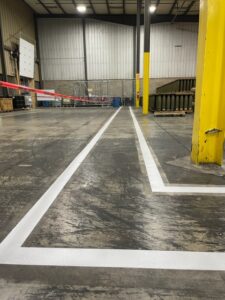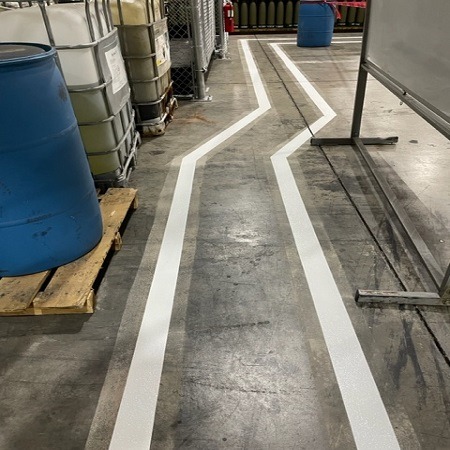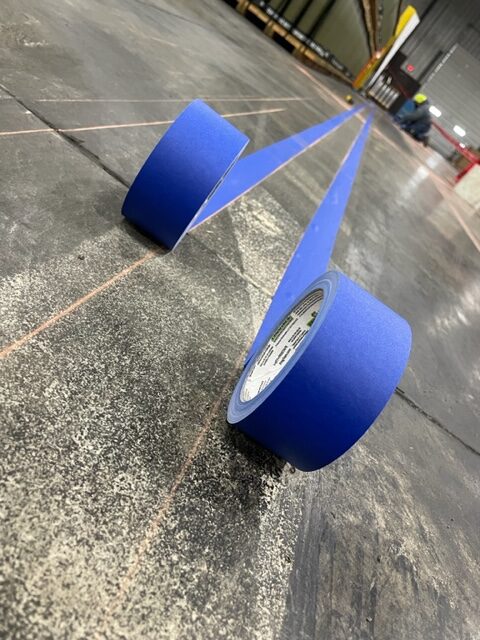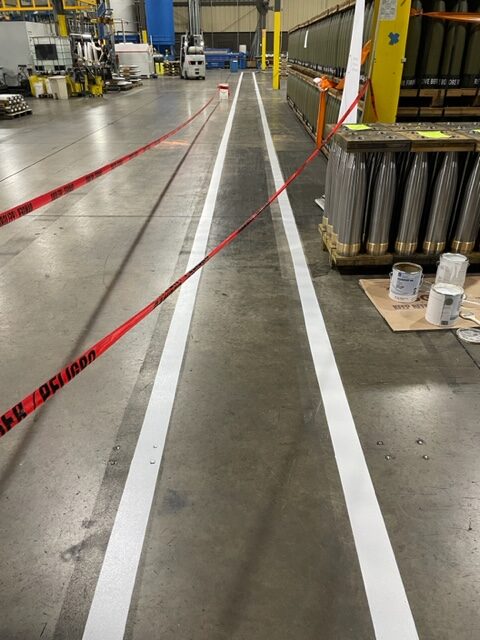5S Floor Marking for Industrial Facility Safety
The 5S floor marking system is a methodology that helps teams optimize work efficiency by creating and maintaining a clean, safe, and organized workspace. A well-implemented 5S system can help to minimize accidents and maximize productivity.
Let’s investigate the history of 5S floor markings, their role in warehouse and factory efficiency, what the floor marking requirements are, and the best practices for implementing them effectively.

The History of 5S Floor Markings
According to 5S Today, the 5S system originated in Japan and became well-known throughout the world as a part of Toyota’s efficient vehicle production system. This method is often used by businesses employing lean manufacturing practices. The five pillars of 5S are seiri (sort), seiton (set in order), seiso (shine), seiketsu (standardize), and shitsuke (sustain).
1. Sort
The first pillar stands for sorting, emphasizing the importance of keeping only necessary items in the workplace. It involves separating essential items from non-essential ones and disposing of the latter. By doing this, you can identify and eliminate inefficiencies in the workplace, and free up space for important materials. Sorting also helps to reduce clutter, simplify processes, and minimize the risk of accidents.
2. Set in Order
Setting in order is about organizing necessary items into a logical and easy-to-use system. It involves organizing the workplace in a way that promotes efficiency and productivity. This principle encourages the use of floor markings to designate specific areas for different activities, such as storing items, moving equipment, and walking paths. Set in order helps to streamline workflows, reduce time wasted looking for items, and increase warehouse safety by preventing accidents.
3. Shine
Shine, the third pillar, refers to keeping the workplace clean and free of clutter. It involves maintaining a clean and orderly workplace that is free from dirt, dust, and debris. This principle emphasizes the importance of regular cleaning and maintenance to keep the workplace safe and hygienic. Shine also helps to prolong the lifespan of equipment, and reduce the risk of accidents caused by slips, trips, and falls.
4. Standardize
The fourth pillar, standardize, emphasizes standardizing these processes and making them part of the daily routine. It involves developing standard procedures and guidelines for workplace organization, cleaning, and maintenance. This principle helps to ensure that everyone in the organization follows the same rules and procedures, and that the workplace remains organized and safe. Standardize also helps to improve communication, reduce errors, and increase productivity.
5. Sustain
The fifth pillar represents sustaining this organization and keeping the workplace in a constant state of improvement. This means creating a workplace culture that is committed to continually assessing and improving processes, not just during the initial implementation of 5S. Without this critical fifth pillar, the organization risks falling back into old habits and losing the benefits gained from the initial implementation of 5S. The success of the 5S system is dependent on the ability to sustain it for the long term, ensuring that the workplace remains organized, efficient, and productive.
6. Safety
Safety is the unofficial sixth pillar of the 5S methodology. When the others are implemented, safety naturally improves as well. An organized and efficient workspace is a safer workspace.

Color-coded 5S Floor Marking Examples
Distinct colors are used in 5S floor marking to designate various areas and functions within a warehouse or factory. Some common 5S floor marking examples can include:
- Yellow: Indicates pathways, aisles, and traffic lanes
- Red: Highlights hazardous areas, fire equipment, and emergency stop buttons
- Blue: Designates equipment, tools, and workstations
- Green: Marks safety and first-aid equipment
- White: Outlines storage areas, racks, and shelves
Additional colors can be incorporated to create standards for staff to follow. Symbols or text can also be printed on the floor marking tape to identify what goes within each area. It’s essential to establish and adhere to a consistent color scheme across the entire facility to maintain clarity and efficiency.
Tips for Implementing 5S Floor Markings in a Factory
When implementing 5S floor markings in an industrial or commercial facility, consider the following five tips:
1. Choose the right type of floor marking – Several types of floor markings are available, such as tape, paint, and pre-formed thermoplastic markings. Consider factors such as durability, ease of installation, and maintenance when selecting the right type for your facility. Invest in long-lasting flooring materials, such as epoxy or polyurethane coatings, to ensure that your markings remain visible and effective over time.
2. Integrate safety floor markings – Incorporate safety symbols and hazard warnings in your floor marking plan to alert workers of potential hazards and safety procedures. Engage employees in the 5S process by soliciting their input and suggestions for improvement.
3. Create cleaning routines – Regular cleaning is an essential element of the 5S system, as it helps maintain the effectiveness of floor markings and keeps the workplace safe. Keeping floors clean not only ensures the visibility of floor markings but also minimizes the risk of accidents caused by debris and spills.
4. Maintain clear pathways – Keep aisles and passageways clear of obstructions to facilitate smooth movement of workers and equipment.
5. Review and update – Perform regular inspections to ensure that the 5S system is being followed and maintained. Address any issues or discrepancies immediately to ensure the continued success of the system. Continuously assess and update your floor marking system as needed to accommodate changes in your facility’s layout, workflow, or safety requirements.


5S Floor Markings and Resinous Flooring Systems
Resinous flooring systems can be paired with the 5S methodology to create a space that prioritizes cleanliness, safety, and productivity, while also being easy to maintain and impact-resistant. Industrial epoxy and resin coatings can be installed to meet floor marking requirements or incorporate unique coating customizations.
Surface Technology, Inc works with commercial and industrial facilities across the United States to create professional and effective results. Using premium materials and proven process, the Surface Technology team can create custom solutions to flooring challenges. Get more information about our installation process here or contact us to get a quote for your space.
Get in Touch
We know you’re busy. We’re here to get you the information you need as quickly as possible. Whether you just want a quick estimation on your project specifications or want to talk to an expert about your project, we are here to help you.

